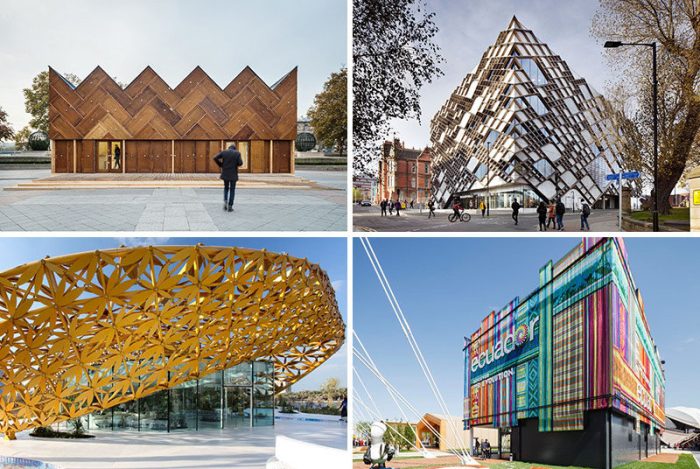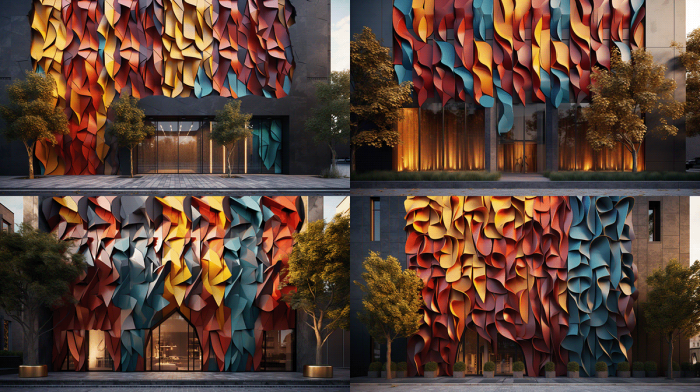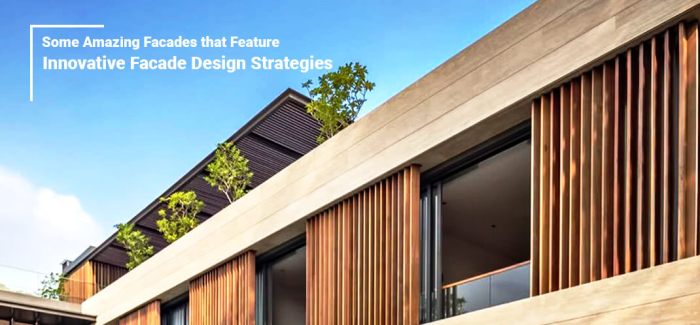Creative facade design concepts immerse us in a world of innovation, sustainability, and technology, where aesthetics meet functionality in architectural marvels. From colorful schemes to greenery integration, this captivating journey explores the essence of modern facade design.
Discover how cultural influences and cutting-edge technologies converge to create visually stunning and environmentally conscious building exteriors.
Creative Facade Design Concepts

When it comes to facade design, creativity knows no bounds. Architects and designers around the world are constantly pushing the boundaries of what is possible, creating stunning and innovative facades that not only beautify buildings but also serve functional purposes.
Innovative Facade Designs
One example of an innovative facade design is the Bosco Verticale in Milan, Italy. This residential tower is covered in vegetation, creating a vertical forest that not only provides a striking visual impact but also helps improve air quality and reduce energy consumption.
Another remarkable facade design is the Burj Khalifa in Dubai, United Arab Emirates. The world’s tallest building features a sleek and reflective glass facade that not only enhances its aesthetic appeal but also helps regulate interior temperatures and reduce the building’s energy consumption.
Use of Sustainable Materials
- One of the key trends in facade design is the use of sustainable materials such as recycled glass, reclaimed wood, and eco-friendly composites. These materials not only reduce the environmental impact of construction but also add a unique and natural touch to the building’s exterior.
- For example, the Bullitt Center in Seattle, Washington, is known for its innovative use of sustainable materials such as FSC-certified wood and energy-efficient glass. The building’s facade not only looks visually appealing but also contributes to its overall sustainability.
Importance of Natural Lighting
Natural lighting plays a crucial role in enhancing the aesthetics of a facade. It can highlight architectural details, create visual interest, and improve the overall ambiance of a building.
Architects often incorporate features such as large windows, skylights, and light shelves to maximize natural light penetration into the building’s interior. This not only reduces the need for artificial lighting but also creates a more pleasant and inviting environment for occupants.
Elements of Creative Facade Design

Color schemes play a crucial role in transforming the appearance of a building’s facade. They can evoke different emotions, create visual interest, and contribute to the overall aesthetic appeal of the structure. By carefully selecting and combining colors, architects and designers can make a bold statement or blend the building harmoniously with its surroundings.
Role of Color Schemes in Facade Design
Color schemes in facade design can significantly impact how a building is perceived. Here are some key points to consider:
- Colors can affect the perceived size and scale of a building. Light colors tend to make a structure appear larger, while dark colors can create a sense of depth and intimacy.
- Contrasting colors can highlight architectural features and add visual interest to the facade.
- Harmonious color schemes can create a sense of unity and coherence, tying together different elements of the building’s design.
- Colors can also reflect the identity or branding of the building occupants, conveying a specific message or image.
Impact of Textures and Patterns on Facade Design
Textures and patterns can add depth, dimension, and character to a building’s facade. Here’s how they contribute to the overall design:
- Textured surfaces can create visual interest and tactile appeal, inviting closer inspection and interaction with the building.
- Patterns can be used to break up large surfaces, create rhythm, or establish a sense of movement across the facade.
- Combining different textures and patterns can add complexity and richness to the design, enhancing the building’s aesthetic appeal.
- Textures and patterns can also serve functional purposes, such as providing shading, improving insulation, or enhancing acoustics.
Incorporation of Greenery and Vertical Gardens
Greenery and vertical gardens are increasingly being integrated into modern facade design concepts, offering numerous benefits beyond aesthetics:
- Green elements can improve air quality, reduce urban heat island effect, and provide habitat for wildlife in urban areas.
- Vertical gardens can help insulate the building, reducing energy consumption and creating a more sustainable environment.
- Plants and greenery can soften the harshness of urban landscapes, creating a more inviting and livable space for occupants and passersby.
- Green walls can also contribute to the building’s biophilic design, connecting occupants with nature and enhancing their well-being.
Technology in Facade Design: Creative Facade Design Concepts

In the realm of facade design, technology plays a pivotal role in pushing boundaries and creating innovative and futuristic structures. From 3D printing to parametric design, smart facade systems, augmented reality, and projection mapping, technology has revolutionized the way we perceive and interact with building facades.
3D Printing and Parametric Design
D printing has opened up a world of possibilities in facade design, allowing architects and designers to create intricate and unique patterns and shapes that were once unimaginable. This technology enables the fabrication of complex geometries with precision and efficiency, leading to the creation of visually striking facades that stand out in the urban landscape. On the other hand, parametric design enables the generation of complex forms based on algorithms and parameters, resulting in dynamic and adaptive facades that respond to environmental conditions and user needs.
Smart Facade Systems
The integration of smart facade systems has become increasingly popular in modern architecture, as buildings strive to become more energy-efficient and sustainable. These systems incorporate sensors, actuators, and control systems to optimize natural light, ventilation, and thermal performance, thus reducing energy consumption and enhancing indoor comfort. Moreover, smart facades can also be designed with interactive features, allowing users to engage with the building through customizable elements and dynamic displays.
Augmented Reality and Projection Mapping
Augmented reality and projection mapping have emerged as powerful tools in enhancing building facades with dynamic and immersive elements. By overlaying digital content onto physical surfaces, architects can create interactive experiences that blur the line between the virtual and physical world. Whether it’s projecting art installations, interactive displays, or real-time information, these technologies add a layer of storytelling and engagement to building facades, transforming them into dynamic canvases that captivate and inspire passersby.
Cultural Inspirations for Facade Design
In the realm of architecture, cultural heritage and traditions play a significant role in influencing facade designs across different regions. These elements are often seamlessly integrated into modern structures, creating a unique blend of historical aesthetics and contemporary design concepts. Furthermore, storytelling through facade elements serves as a powerful medium to reflect cultural identities, allowing buildings to communicate their heritage and history to the world.
Blend of Historical Aesthetics and Contemporary Design
In various parts of the world, architects have successfully blended historical aesthetics with contemporary facade design concepts to create visually striking buildings. One notable example is the Louvre Abu Dhabi, which combines traditional Islamic architecture with modern design elements. The intricate latticework and geometric patterns found in traditional Islamic buildings are reinterpreted through a modern lens, resulting in a facade that pays homage to the region’s cultural heritage while embracing innovation.
Storytelling Through Facade Elements, Creative facade design concepts
Facades can be used as a canvas to tell stories and convey cultural identities. The National Museum of African American History and Culture in Washington, D.C., is a prime example of how facade elements can reflect the history and heritage of a community. The building’s facade features intricate bronze-colored panels inspired by the ironwork crafted by African American slaves in the American South.
These panels not only serve as a striking design element but also symbolize the resilience and strength of the African American community.